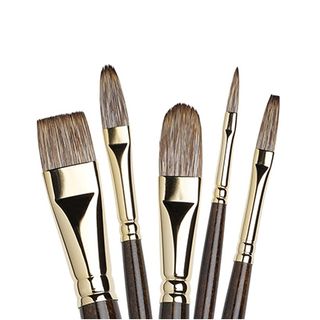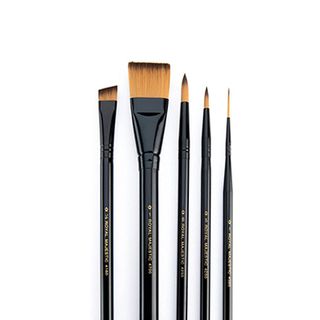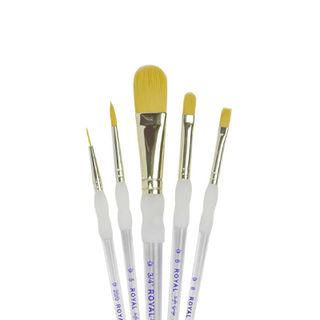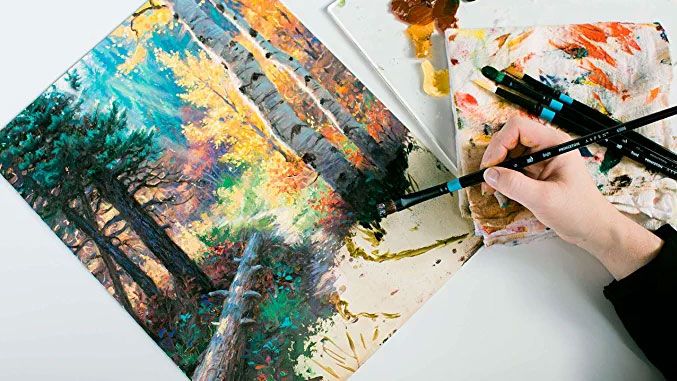If acrylic paint is your medium of choice, you’ll want to ensure you have one of the best acrylic paintbrushes to get the most out of your paints. Of course, choosing is no simple task, with a huge range of options available, but that’s where we come in to help you choose.
You’ll want sturdy, versatile brushes that are easy to maintain, while also factoring in your individual needs like your level of experience and budget. Some brushes are also better for specific styles and tasks, so we’ve made sure to include a broad range of options.
While you’re at it, make sure to shop for the best acrylic paints, because there’s nothing worse than being let down by your media. Or, opt for something a little different; we’ve got recommendations for the best watercolour pencils, and have also compared acrylics vs oils, too. To finish decking out your studio, it’s also worth considering one of the best easels to support your work.
The best acrylic paintbrushes
 Best overall
Best overall
Quality: professional
Firmness: very firm
I find these excellent synthetic substitutes for hog hair to be very springy and much firmer than others while not as scratchy as hog. They feel smoother laying down paint. These are likely to leave brushstrokes, making them the best acrylic brushes for a textured approach, and they’re robust enough to handle heavy paint and mediums and expressive brushwork.
 Most natural
Most natural
02. Winsor & Newton Monarch
Quality: professional
Firmness: quite soft
These synthetic brushes do a good job of emulating mongoose hair. They have a little extra firmness, which helps push thicker paint around, but they’re still quite soft. The bristles are tightly packed, holding their shape well, which results in a nice, crisp edge. I find these to be the best acrylic paintbrushes for responsive blending and detail work.
 Best value
Best value
Quality: intermediate
Firmness: medium
This solid, mid-range brush is a little firmer than most but soft enough to blend well. They have a smooth feel, rather than springy and don’t leave much of a stroke. The tip comes to a fine point and holds its shape. They’re also surprisingly good at holding paint, which combined with the long handles, helps to pull longer strokes with precision.
 Best detail
Best detail
04. Royal and Langnickel Majestic Brushes
Quality: intermediate-professional
Firmness: medium
Though aimed at watercolourists, these are robust enough as paintbrushes for acrylic paint. They’re a little firmer than most synthetic brushes, but still flexible and come to a fine point – excellent for adding fine details. For their price, this range runs a little on the small side, but they’re quite hardwearing, and the large sizes hold their shape especially well.
 Best student
Best student
Quality: student
Firmness: quite soft
These have a more professional feel than most student acrylic brushes. They have a long handle – useful for more expressive mark-making and the bristles are quite soft for a smooth application of paint. This makes them less suitable for use for textural work with very thick paint or mediums. Over time they can start to lose shape.
 Best beginner
Best beginner
06. Royal Langnickel soft grip brushes
Quality: student
Firmness: quite soft
These brushes are a great cheap-and-cheerful option for anyone starting. A decent choice for clean strokes, the bristles are quite soft, and the soft grip is comfortable to hold. Whilst they don’t hold as much paint as other brands, they typically come back to a decent point after cleaning, and they’re flexible enough to feel quite responsive.
FAQs
What brush should I use for acrylic paint?
Generally, the best paintbrushes for acrylic paint are synthetic rather than natural brushes since synthetic brushes are tougher, so they can cope better with the medium. All of our choices in our picks of the best acrylic paintbrushes are synthetic – though some emulate the feel of natural hair but offer a firmer brush.
When working with acrylics, we recommend using a selection of different shape and size brushes – large brushes are useful for applying broad areas of colour quickly. Brush texture is worth considering too. Soft brushes suit blending and produce a smoother paint surface, while firmer brushes leave expressive marks and produce more textured effects.
How should I clean the best acrylic paintbrushes?
Whichever option you choose as the best paintbrushes for acrylics for you, it’s important to clean your brushes thoroughly after use. Acrylic paints can be particularly hard on paintbrushes and they’re difficult to clean off once dry. Whilst a lot of brushes suitable for oils work with acrylics, both are hard on brushes in different ways. Cleaning undiluted acrylic paint from brushes is similar to oil paint, but you just use water rather than spirit or oils.
Clean off as much paint as you can using a clean cloth or paper towel by wrapping the cloth around the ferrule of the brush and squeezing it with your thumb and forefinger. Work up towards the end of the bristles and repeat as many times as you need. You can use water in a jar or brush washer to clean as much paint as you can from the bristles, and then use a brush cleaner for a thorough clean (see our complete guide to how to clean paintbrushes for recommendations).
How often should I replace my acrylic paintbrushes?
Brushes don’t last forever, and will eventually need to be replaced. However, with proper care, your acrylic paintbrushes can last for years. So it’s less a question of how long you should leave it and more about keeping an eye on the state of your brush. Signs that your paintbrushes need to be replaced include split or frayed bristles, loss of elasticity and difficulty holding paint.
How to choose the best acrylic paintbrushes
When you’re choosing the best acrylic paintbrush for you, there are a couple of key factors to consider. First, pay attention to the bristles. Acrylic paint can be hard on brushes as its texture means it’s tricky to clean off once dry, and if you want your brushes to last you’ll want to make sure they’re easy to clean. So although you can buy brushes with natural hair, the best brushes for acrylic paint are normally synthetic because they’re tougher.
Also, think about shape and size. Flat brushes are great for covering large areas and applying base coats. Round brushes are a good choice for details, blending, and controlled lines. Filbert brushes (flat with rounded edges) are useful for blending and creating smooth curves. Angle brushes are ideal for sharp lines and edges, whereas fan brushes are good for creating textured effects and foliage.
How we test the best acrylic paintbrushes
In this guide, I’ve selected the best acrylic paintbrushes based on my own experience as an artist. I’ve tested each of these brush options with a range of acrylic paints and different approaches to evaluate their performance, durability, and versatility. Based on my testing, I’ve picked out the options above that I think are suitable for artists with different levels and styles.

 Best overall
Best overall Most natural
Most natural Best value
Best value Best detail
Best detail Best student
Best student Best beginner
Best beginner